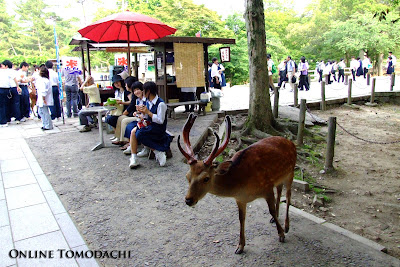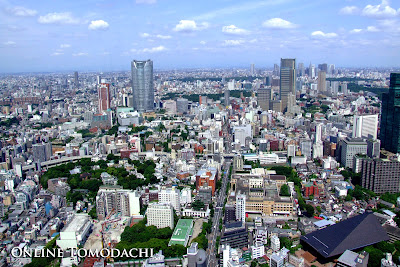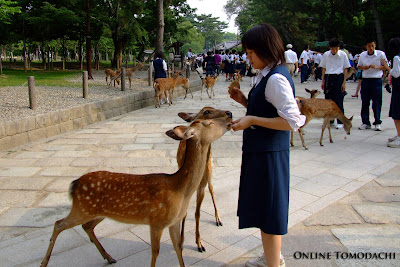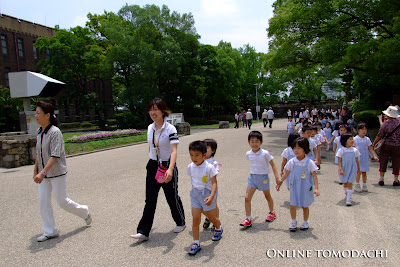This article is from Japan Ministry of Foreign Affairs website about a Brunei Primary School at Kampung Ayer (Water Village). It's in Japanese, so if you know how to read Japanese then have a look, if not get it translated. Click the link below to view.
Sunday, 25 November 2012
Friday, 23 November 2012
If you are visiting Kyoto, Japan then Kinkaku-Ji (temple) is a wonderful place to visit and a must visit. Kinkaku-Ji or the Golden Pavilion is a Zen Buddhist temple in northern Kyoto whose top two floors are completely covered in gold leaf. It is formally known as Rokuon-Ji and was the retirement villa of the shogun Ashikaga Yoshimitsu. Kinkaku-Ji is an impressive structure built overlooking a large pond, and is the only building left of Yoshimitsu's former retirement complex. It has burned down numerous times throughout its history including twice during the Onin War which destroyed much of Kyoto, and burned down once again more recently in 1950 when it was set on fire by a monk. The present structure was rebuilt in 1955.
Monday, 15 October 2012
Japanese Koi
Koi or Nishikigoi (in Japanese), are a popular fish around the
world, and are kept for decorative purposes in outdoor Koi ponds or water
gardens. Koi varieties are distinguished by coloration, scalation and
patterning. Some of the major colors are white, black, red, yellow, blue, and
cream.
Japanese Koi fish are specifically bred for both coloration
and form. Most popular in Japan are the Kohaku, a pure white fish with
persimmon-red patches arranged in a stepping stone pattern.
In Japan, Koi are known for their masculine and positive qualities. They are the official symbol for the Japan Children's Day on May 5th, which is also a festival in Japan. During this festival families hang a Koi Fish windsocks or Koino Bori (see below) for every member they have in their household. Another Japanese believes is that Koi fish symbolise strength for overcoming life's difficulties. Other than that Koi fish is a part of Japanese culture that can be found in some homes or parks around the world.
Friday, 5 October 2012
Japanese Coin Pouch
Japanese Coin Pouch, It's a must get when you are in Japan for putting Japanese Coins. I'm sure most guys wallet doesn't have a coin pocket in in nowadays, and it can be very inconvenience when you are in Japan because they still uses a lot of coins in their market. This Japanese coin pouch can be easily store in your pockets wherever you go.
The Japanese Coin Pouch comes with many design and patterns, but the shapes are all almost the same. You can easily buy them from any souvenir shops, and also from 100 Yen shops. It can also be a good souvenir to get for friends and family :-)
 |
| Sample of Japanese Coins |
Sunday, 9 September 2012
Tokyo City Sky View
Monday, 27 August 2012
Deer in Nara
 |
| Konichiwa.... Yokoso Japan! |
Deer are everywhere in Nara, Japan. You can almost see them immediately the moment you reach Nara prefecture. You can see them the most at Nara Park and at Todai-Ji (Temple).
According to Nara locals' story, Deer from this area were considered sacred due to a visit from one of the four gods of Kasuga Shrine, Takenomikazuchi-no-mikoto. It was said the god appeared on Mt. Mikasa-yama riding a white deer. From that point, the deer were considered divine and sacred, protecting the city.
Now the Deer in Nara are considered as national Treasures and are protected by the local government. So now the deer roam around the town, especially in Nara Park. Snack vendors sell "Shika Sembei" or Deer Biscuits to visitors so they can feed the deer. But be careful not to have any papers around you, the Deer tend to take a bite on it.
 |
| This Deer is waiting for someone to feed it |
Photos Courtesy of Forest Han Photography
www.foresthantravel.blogspot.com
Monday, 23 July 2012
Have a cup of Flavoured Ice in Japan
Feeling hot during Summer time in Japan? Get yourself a cup of flavoured Ice to cool yourself down. In Japan this is called "Kakigori", the Japanese version of a Snow Cone except in a cup and you eat it with a spoon. Kakigori comes in different flavoured such as Green Tea, Grape, Blueberry, Peach, Lemon, Cherry and so on. It is also popular to add sweetened condensed milk to it or sometimes red beans, fruits or Mochi to enhance the taste.
Kakigori can be found almost anywhere in Japan during the summer time. Street vendors selling it are usually around especially during a festivals, at the train stations, a street fairs and other popular places where a lot of people gather or visit. So if you are visiting Japan in the Summer time make sure you try one Kakigori, it's cool & delicious :-)
Tuesday, 10 July 2012
Monday, 4 June 2012
Taxi in Japan
Taxi can be found everywhere in Japan. It is one of the common transportation use there. It may be expensive to ride one if you are going on a long journey, but to go around fast in the city it can be convenience especially late at night when all the other public transportation shut down.
In Japan smaller cities, Taxi are more often use than the other public transportation and it can help you save time instead of waiting for a bus. Taxi fares typically start around 600-700 YEN for the first two kilometers and increase about 100 yen for every additional 500 meters traveled. The cost is also counted when the taxi is not moving for a prolonged time. Late in the evening the rates are raised by around 20 percent. I'm sure this is the same with other countries. Traveling in a group of four is advise to reduce the fare when it's break down to a person. Oh ya, you can pay the Taxi fare with a credit card, just ask the Taxi driver before you enter.
In Japan the Taxi's left rear door is opened and closed remotely by the Taxi driver. You do not need to open or close the door. For a foreigner who can't speak Japanese well, communication with the Taxi driver can be a problem. Taxi drivers there don't really know how to speak English. So it is advice to give your driver the address of your destination on a piece of paper or point it out on a map, or have the telephone no. of the place you are going for the Taxi driver. Sometimes places in Japan can be confusing even for a Japanese.
Visit here to learn some Japanese language for calling a Taxi
 |
| A typical Japanese Taxi GPS Device |
Thursday, 24 May 2012
Japan Postcards
Want to get a souvenir in Japan for your friends? Get them a nice Japan postcard.
You can collect the entire postcards from places you visit in Japan. It can be fun and interesting searching and browsing for a nice Japanese postcard. You can get Japanese Postcards at almost anywhere in Japan. In souvenir shops, book shops, department store, temples, shrines, subways and even on some shops on the streets of Japan. There are also free postcards you can collect from hotels and sometimes from restaurants.
Japanese postcards can be a good collection from your trip to Japan. For example in Kyoto you can buy unique postcards of Maiko & Geisha for collection (you can see some above). Japanese postcards are not that expensive, and the photo printing quality is very good. One thing you can do when you are in Japan is you can buy a nice Japanese postcard, and then mail it to your friends or even to yourself for fun. Try it :-)
Wednesday, 16 May 2012
Big G-Shock Watch
Casio G-Shock Watch is one of the most popular watch in the world. It's common to see Outdoor enthusiastic, Travelers, Athletes, Photographers, Campers and even the Army to have a G-Shock watch on their wrist. It is one of the toughest watch around.
Monday, 7 May 2012
Ganbatte to all the Children of Japan :-)
A project done by Cikgu Lim Han with his Year 5 students in his school in the Brunei Water Village (Kampung Ayer). His students is sending their caring messages to all the Children of Japan working hard recovering from last year tragic incident of Tsunami, Earthquake and Nuclear crisis. Ganbatte to all the Children :-)
#If you have similar project please do share with us at our Facebook page, thanks.
Sunday, 29 April 2012
Japanese Green Tea Kit Kat
Have a Break, Have a Japanese Green Tea Kit Kat........
Japanese Green Tea Kit Kat or Matcha Kit Kat can be found in most convenience store in Japan. This green tea flavour Kit Kat is very delicious and it's nice to buy back as gift for your friends and family, a unique souvenir from Japan. Can't say much about it, try it yourself. It taste like eating a Kit Kat and drinking Japanese green tea at the same time.
Monday, 16 April 2012
Walk around Osaka Castle
Osaka Castle or Osaka-Jo (in Japanese), is a famous landmark, a popular sightseeing spot in Japan. This castle is the symbol of Osaka and its famous around the world. The sheer height of the walls and the wide channels make for a grand sight that can be matched by no other castle in Japan.
The Osaka Castle was built in the end of the 16th century by Toyotomi Hideyoshi, a well-known warlord who brought the whole country under his rule in the late 16th century. Unfortunately, it was burned down in a series of battles in the 17th century, and reconstructed later. But later again it was destroyed by fire and was reconstructed at last early in the 20th century.
Another interesting thing about the castle is there are eight roof dolphins, and the decorative roof tiles and reliefs are carved in the shape of tigers, all of which are gilded with gold. There is a museum inside the castle with a large variety of historical materials and screen displays, and also the miniature figures depicting the Summer War of Osaka.
The steep walls of Osaka Castle is about 30 meters high are made of huge blocks of stone that were transported to Osaka from quarries over 100 kilometers away. The top floor of the castle is an observation deck where you can enjoy panoramic views of Osaka Castle Park, part of the modern high-rise buildings, the Osaka plain, and mountains in the distance. It a good place for photography.
With waterways running around the castle, there is a water bus service that takes you out on a 1-hour cruise in the river that flows through the city. In summer, the Okawa River in the northwest of the Osaka Castle becomes the stage for the Osaka Tenjin-matsuri Festival. This festival is known as one of the three largest in Japan with sight of a fleet of about 100 ships going down the river. And at night there will be wonderful Japanese Hanabi (fireworks) show.
Osaka Castle is a good place to walk around for sightseeing or just for relaxing. Even children & students like to visit the castle for their school trips. Or just have a sit to enjoy your lunch. You can buy nice Japanese Bento at the castle's compound, and also you can get nice souvenir at the shops there.
If you visit here you must try the train provided for your amusement. It will be fun.
If you just want to visit a beautiful park in Osaka, have a visit to the Osaka Castle Park outside the castle. It is offering a suitable trails and pleasant scenery to enjoy along the way.
For more information about Osaka Castle, please visit here:
Photos courtesy of Forest Han Photography
Friday, 6 April 2012
Daruma Doll
Daruma Doll comes with both eyes blank. When you buy one or received one as a gift, you should paint one eye and make a wish or determine to do something. Then paint the other eye when your wish comes true or something you set out to do is completed. Daruma Doll have a weighted bottom and rounded shape that forces it balance itself back after being knocked over. The lesson here is to never give up and get up from any misfortune. Daruma Doll can also be use for bringing in luck.
Daruma Doll is a great gift for friends and family from Japan. It is also good for decoration and you can buy it from any Temple or any Japanese gift shop all over Japan. It comes in different sizes, design and colours. Make sure you get the right one for yourself or your friends. I'm not sure what's the meaning, but you can always ask before you buy one.
Monday, 26 March 2012
Karate
Karate or Karate-Do is one of the most popular Martial Art from Japan which was originally developed in the Ryukyu Islands in what is now Okinawa. A Karate practitioner is called a Karate-Ka.
Karate is the art of punching, kicking, knee and elbow strikes, and open-handed techniques such as knife-hands. Grappling, locks, restraints, throws, and vital point strikes are also taught in some styles. Some people learn Karate as a form of self-defense, while others practice it as a competitive sport. Well there are those who practice it as a Traditional Martial Art.
The most common style of Karate found around the world is:
-Gojo Ryu
-Shotokan
-Wado Ryu
-Shito Ryu
-Kyokushinkai
(Did i not list other styles in here? Yes, because there are too many others, and like i said this are the most common style found around the world)
 |
| Shihan Sabri leading the Karate Training |
Questions: What's the different in the styles? or you want to know more ?
Answer: Google it up yourself :-)
 |
| Fukamizu Sensei from Universal Shotokan Karate Union (USKU), Japan |
A Karate-Ka wears a White Karate Gi (Uniform) & a Obi (Belt) for training. The levels of the Karate-Ka are determined by the colours of their Obi. White (Shiro Obi) for beginner, and Black (Kuro Obi) for Advance or Master. This is the same in all style of Karate style except for the other colours Obi which are different or in a different order.
For a Kuro Obi (Black Belt) there are also different ranks in it which are:
-Sho Dan
-Ni Dan
-San Dan
-Yon Dan
-Go Dan
-Roku Dan
-Nana Dan
-Hachi Dan
(This means 1st Degree Black Belt to 8th Degree Black Belt)
Usually in Karate training, the Karate-Ka train Kihon (Basic), Kata (Pattern) and Kumite (Sparring). Other forms of training like self-defense are usually taught along with the training. Karate is not just for Men, Ladies also take up this Martial Art around the world as a good form of practice both for Self-Defense and competition.
Karate is one of the most popular cultures from Japan. It can be found in almost all countries especially in school clubs to a University club, even in a private club. It is also one of the most popular competitive sports in many Games events around the world and it's also practiced by young children all the way to people at an old age. Karate is not just a form of Martial Arts; It's also a good form of fitness and health.
Photos from Brunei Shotokan Karate training.
Photos courtesy of Forest Han
More photos can be found at Online Tomodachi Facebook page
Subscribe to:
Comments (Atom)

















































